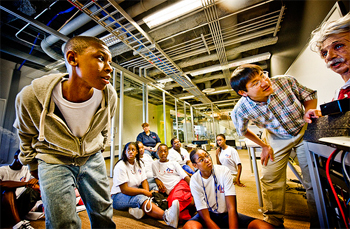Young Students 'Reach for Tomorrow' at Calit2's Machine Perception Lab
By Tiffany Fox, (858) 246-0353, tfox@ucsd.edu
San Diego, CA, July 29, 2009 — Eric Sabb is convinced that the "facial remote control" developed by the University of California San Diego's Machine Perception (MP) Lab will one day revolutionize the way he gets his movie fix.
|
"This will change the world greatly," Sabb predicted after viewing a demo of the software, which recognizes a viewer's facial expressions and then modifies the speed of a pre-recorded video according to those perceived expressions — without the assistance of a hand-held device.
"Think of it: No more batteries for our remotes!" he enthused, a smile lighting up his face.
Sabb might indeed see the day when the facial remote is a fixture in every household. A middle school student at the Integrated Design Electronics Academy (IDEA) Public Charter School in Washington D.C., Sabb was one of 46 students to visit UC San Diego's California Institute for Telecommunications and Information Technology (Calit2) last week to get an eye- and an earful of the MP Lab's cutting-edge research in computer science and robotics.
The students were participants in the nationwide Reach for Tomorrow (RFT) program, a non-profit organization that motivates teens and pre-teens in grades 7 through 10 in selected public and charter schools to perform to their highest potential. RFT's strategy stems from the notion that pre-high school years are critical years in a young person's life and frequently determine their subsequent academic and career opportunities. Chairman and founder Peter K. Underwood describes the typical RFT student as a "middle of the bell curve, average student who has the capacity to do better."
|
Since its inception in 1993, RFT has partnered with numerous foundations, corporations, universities and other institutions to sponsor its Summer Program, a week-long excursion (this year, to UC San Diego) that exposes students to state-of-the-art technology and scientific innovation at no cost to the student. The RFT program at UCSD is sponsored by the Temporal Dynamics of Learning Center, which is funded by the National Science Foundation's Science of Learning Centers.
It doesn't get much more state-of-the-art than the Einstein Robot, a head-and-shoulders automaton complete with a bushy mustache (his mop of gray hair was removed so students could see his internal parts). As part of their tour of the lab, the RFT students were able to interact with the robot and even touch a piece of its skin — a material called "Frubber" that is specially designed to resemble human flesh. A product of the MP Lab, the robot recognizes a number of human facial expressions and can respond accordingly. Scientists consider it an unparalleled tool for understanding how both robots and humans perceive emotion, as well as a potential platform for teaching, entertainment, fine arts and even cognitive therapy.
|
The budding scientists of RFT had plenty of questions for Einstein's creator, research scientist Javier Movellan, as well as Movellan's assistants, graduate students Nick Butko and Tingfan Wu. One student wanted to know how much the robot cost (A: $17,000). Another wondered if it could help him do his homework (A: Potentially). A third wanted to know if the robot wears dentures (A: He does, but there's no risk of him biting his tongue because he doesn't have one).
Students also got a look at RUBI, a robot tutor equipped with an Intelligent Tutoring System that teaches pre-school children colors, shapes, and even vocabulary words. The general consensus was that RUBI (which required only $200 to make, plus the cost of a laptop) seemed "more like a toy" and thus, friendlier than hyper-realistic Einstein (who snarled and made a face when one student got too close).
The students were also invited to interact with a suite of computer games developed in the MP Lab, including a custom-designed memory game designed for people with autism to help them recognize and understand facial expressions.
The RFT visit to San Diego also included a few hours with the Scandinavian Aviation Academy and the National Air College, where the students got to pilot planes and attend ground school. General Atomics (a frequent collaborator on UCSD faculty-led projects) presented the students with a lab on fusion, and the San Diego Science Alliance hosted a chemistry lab. Activities also included snorkeling, surfing, a visit to the Midway aircraft carrier and the USS Stockdale (a destroyer), a robotics lab at the Preuss High School at UCSD, and a marine science lab at the Sea Camp on Fiesta Island. Each student also toured the U.S. Navy Depot and interacted with civilian craftsmen rebuilding aircraft to discover new career fields they never realized were available.
"I don't ever plan an event that won't require them to use their noodles," Underwood remarked. "Everywhere we go, these students have to figure out something, solve some problem."
Retired Major Lorenzo Catten, a chaperone for this year's Summer Program and a former administrator of IDEA, says he volunteers with RFT every year because he sees tremendous value in the organization.
"I tell the students they can go to any college in the United States, but they are going to be evaluated for both their attitude and their aptitude. Where they go in life is based on what they have achieved and what they can achieve.
"With RFT, they see other people who have achieved so much, and that inspires them to do the same."
Media Contacts
Tiffany Fox, (858) 246-0353, tfox@ucsd.edu
Related Links
Reach for Tomorrow, Inc.
Machine Perception Lab
Reach for Tomorrow Visit to MPLab on Flickr




